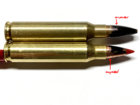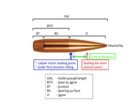I have for awhile become suspicious of my prior attempts to measure the max CBTO of my Blaser 223. Those familiar with this action will know that you can't use the "Wheeler method". Removing the ejector pin requires one to have a brand new one to hand. Plus the straight pull action style doesn't have the feel of a dropping bolt handle. I'd used a 'loosely seated bullet test' before but had become suspicious that bullets were being jammed and then pulled out again on extraction. Anyway so I dragged out a tool I had purchased and not used - the Hornady Max COAL tool. I'd not used this because it is a pain to measure the result properly. I persevered by first measuring the bullet OAL and then subtracting the BBTO measurement estimated with my Forster Datum Dial Kit. This left me with the length from bullet o-give to tip which I could subtract from a COAL measurement and get to an estimated max CBTO for use with this comparator.
The result using the tool surprised me and was markedly different vs my previous loosely seated bullet attempts. I find it all the more confusing when I compare it with a loaded round with a Sierra Matchking 52 grain bullet. (I do not have some of these bullets, just this one loaded round.) I'm probably having a brain fart but I'm confused by the following.
See attached pic. Sierra Matching round on top. Hornady modified case with 52 gr ELD-M sitting in it at the length to 'touch' in the chamber.
If I chamber the Sierra round with the bullet marked with a Sharpie I don't see any sign that the bullet is jammed in the rifling. So it is either nestled close to touch or has some jump.
You can see where the Forster Datum Dial touches the bullet. Given the ELD-M is more pointed the comparator hits higher (away from the point) than the Matchking. What I don't understand is why the ELD-M doesn't sit at a longer CBTO. If we assume the Sierra round is sitting at touch the rifling would be touching both these rounds at the same point. Given the ELD-M is pointier than the Matchking the rifling contact point must be to the left of the lower comparator point. Yet looking at the shape of the MK I wouldn't expect it to touch so far away from where it hits the comparator. Maybe it's just deceptive.
I've repeated the COAL measurement with the Hornady tool many times with the same result. If it's right my previous estimates of max chamber CBTO were off by about 122 thou!
(I believe the Forster comparator dials are 10 thou less than their nominal calibre i.e. 0.214" for 224 cal.)
The result using the tool surprised me and was markedly different vs my previous loosely seated bullet attempts. I find it all the more confusing when I compare it with a loaded round with a Sierra Matchking 52 grain bullet. (I do not have some of these bullets, just this one loaded round.) I'm probably having a brain fart but I'm confused by the following.
See attached pic. Sierra Matching round on top. Hornady modified case with 52 gr ELD-M sitting in it at the length to 'touch' in the chamber.
If I chamber the Sierra round with the bullet marked with a Sharpie I don't see any sign that the bullet is jammed in the rifling. So it is either nestled close to touch or has some jump.
You can see where the Forster Datum Dial touches the bullet. Given the ELD-M is more pointed the comparator hits higher (away from the point) than the Matchking. What I don't understand is why the ELD-M doesn't sit at a longer CBTO. If we assume the Sierra round is sitting at touch the rifling would be touching both these rounds at the same point. Given the ELD-M is pointier than the Matchking the rifling contact point must be to the left of the lower comparator point. Yet looking at the shape of the MK I wouldn't expect it to touch so far away from where it hits the comparator. Maybe it's just deceptive.
I've repeated the COAL measurement with the Hornady tool many times with the same result. If it's right my previous estimates of max chamber CBTO were off by about 122 thou!
(I believe the Forster comparator dials are 10 thou less than their nominal calibre i.e. 0.214" for 224 cal.)












